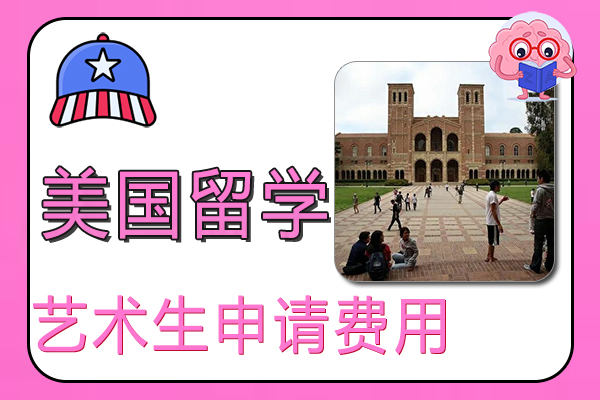The United States has a high quality of education and is one of the top countries for parents to send their children to study abroad. The following is a list of information aboutApplication fees and conditions for art students to study in the U.S,Cost of studying in the United States, ,Analysis of the cost of studying in the United States, ,Cost of studying in the United States for undergraduates, ,Cost of studying at a private university in the United StatesThe problem.

Application Fees and Requirements for Art Students to Study in the U.S.
1. Application fees and conditions for art students to study in the United States
I. Application fees for art students to study in the United States
In addition to the normal tuition fee of $30,000 to $40,000 per year, the cost of living should be estimated to at least $30,000 per year, because the development of art in large cities is naturally better, and the geographical choice invariably raises the cost of living expenses, basically the annual cost is $60,000 to $70,000, which is considered a relatively high cost of studying abroad.
II. Requirements for studying art in the United States
1、Application requirements
There are early admissions for art college entrance exams in China. Candidates in art candidate majors such as art, dance, painting, music, and performance have to meet the required college entrance examination score requirements in addition to the professional examinations. In foreign countries, there is no early admission for art majors. When applying to foreign art colleges, schools require applicants to art colleges to have a certain specialization in addition to a portfolio.
2、Requirements for application materials
The foreign language requirements for art majors in the U.S. are not as high as those for business applicants. Foreign language scores are not as important as personal work. Art students, especially those studying pure art majors (e.g. piano, dance, painting, etc., excluding design and art education), have lower foreign language requirements than other disciplines. However, majors that involve a lot of interaction and communication with people, such as performance majors, will require higher language scores than other majors. At the same time, studying art also requires some artistic temperament, which does not mean looking good, but reflecting good self-cultivation in speaking and acting, which may be of great help during the visa or school interview.
The requirements for applicants to study art in the United States are reflected in the portfolio. The portfolio should show the person's creativity and moldable potential. Even if the applicant's skills are not perfect, students who can show their unique creativity are still very popular with the university.
3、The application requirements of art colleges
The language requirements for art majors in the United States are not as stringent as for other majors, and as long as you have basic communication skills, you can study your major while working on your language skills. You only need to pass the school's professional exam and sometimes you only need to provide relevant artwork to apply to art schools.
III. Job prospects for studying art in the United States
The former includes various design and production majors, while the latter refers to vocal, dance and art majors in the traditional sense. From the overall situation of international students, the proportion of international students in applied arts is higher because international students now pay more attention to employment after graduation and pay more attention to practicality as far as majors are concerned, while the proportion of students in traditional arts is slightly lower.
However, this difference varies from one study abroad country to another, and is mainly determined by the different curricula and subject strengths of art institutions in each country. In Russia, Ukraine, and Belarus, there are fewer applied art classes than traditional art classes in the institutional settings, and in proportion, applied art accounts for 30% and traditional art accounts for 70%. This is mainly due to the higher status and recognition of traditional majors, i.e., classical academy majors, and more advantageous faculty and teaching traditions in the art schools of the three countries in the world. In terms of employment, the applied arts are also different from the traditional arts. The employment of applied art students is more desirable, and the employment of traditional art students is more personal, because it is a different artistic inculcation, and each field is different.
Fourth, the United States art students scholarship application
(1) Broadcast Education Association Foundation
This scholarship provider requires students to provide transcripts, submit work history, submit relevant work, and demonstrate in writing that you are a citizen of good character and have a strong sense of responsibility. Three letters of recommendation are also required to demonstrate that you have a strength in broadcasting that is unlike any other.
(2) International Animation Association
What kinds of art scholarships are available in the United States? This scholarship provider requires the applicant to provide a short competition script about animation, and this animation script must be related to world peace. If you are not providing it as an animation, you can provide it as an animation, and as long as the theme is related to world peace, you can apply for this scholarship.
(3) World Studio Foundation
This scholarship provider offers scholarships in a wide range of fields, including advertising, cartoon production, crafts, ceramics, film, television, and more. However, this provider also requires the applicant to demonstrate a strength or interest in the field and a future commitment to it. This scholarship provider requires applicants to provide transcripts, resumes, financial references, and artwork. When applying, applicants should read their requirements carefully.
V. Recommendation of American Art College
1、lee College MusicBerklee College of Music
Music major in Massachusetts is considered very bull, but can finish the course to get a degree is also very few people, theory arrangement JAZZ are good, do music students can refer to.
2、Center College of Design American Art Center College of Design
And Caltech in the hills of Pasadena, and OXY Caltech can register for each other's courses to sit in on, industrial design, and transportation design is very famous.
3、iard Music Academy
Music scores and certain aspects are one of the top two in the United States, but many are successful people who go on to study and apply after having experience. A favorite of music masters, it is also located in New York.
4、nta College of Art Atlanta College of Art
The unique concept of painting has its own special direction.
5、emy of Art University San Francisco University of the Arts
San Francisco schools, dormitories in the city, relatively cheap tuition, focus on graphic, animation design majors, easy to admit, and high failure rate.
6、fornia College of Art and Crafts
A school that emphasizes design and craft arts, in San Francisco.
2. Advantages of studying art in the United States
Advantages of Art Study in the U.S.
1、Diverse art atmosphere
As a country with a comprehensive cultural collection, the United States allows for the intersection of various forms of culture and art, and can provide sufficient support for multiple genre bodies. The United States has gathered a large number of outstanding artistic talents from all over the world and has many opportunities to participate in world competitions with a strong artistic atmosphere.
2、Strong hands-on ability of students
Compared to domestic art schools, American art universities are often unique in their curriculum, teaching methods, teaching philosophy, and creative thinking of students. For example, their university curriculum is very rich, may cover more than ten subject areas, and is combined with modern technological tools, no longer stereotypical theory. Moreover, students are generally very hands-on and, as a result, their employment is very relevant.
3、Advanced art theory
The United States has always been at the forefront of art theory. American politicians and academics have often repeatedly said that education lacking basic knowledge and skills in the arts can never be called true education, and that education without the arts is an incomplete education.
4、Good employment prospects
The diplomas of art study in the United States are recognized worldwide, and students who study art in the United States have very good employment prospects and can stay in the United States for local internships or graduate jobs. You may want to consider studying art in the United States.
3. The differences between public and private universities in the United States
I. Private Universities
It is well known that private universities in the United States have a longer history and are stronger than public universities. All of the universities in the Ivy League are private universities.
Private universities, or private universities for short, are universities that are primarily run by private capital and are funded by tuition, donations, fundraising, and other non-government funds to maintain their independent, non-profit organization character. Of course, the tuition fees of these universities are usually much higher than those of public universities. Because of this, private universities usually have better student-to-faculty ratios and more resource revenue, which may be one of the reasons why they are ranked higher than public universities.
II. Public Universities
Most U.S. public universities are state universities in various states, and although they are not as outstanding overall compared to a few top private universities, this does not mean that these public schools are very poor. For example, the University of California system and the University of Michigan-Ann Arbor, which we know well, are very good public universities.
In fact, many Chinese students studying in the U.S. are concentrated in public universities because of the cheap tuition at public schools.
A public university is a university that is established and maintained by government funds for public purposes, and in Europe also includes Catholic universities (e.g., KU Leuven). In many parts of the world, public universities are designated by governments as priority development universities (e.g., major universities) and receive particularly generous grants.
III. Public vs. private universities
1、The nature of the school
Public institutions are primarily funded by federal and state tax dollars or local government grants. Private institutions are primarily funded by grants from churches, alumni associations, businesses, foundations, and other sources, as well as by the proceeds of endowments accumulated from these funds.
2、Building time
Private universities have a far longer history than public universities, with traditional American universities such as the eight institutions of the Eastern Ivy League being private. It was not until the latter half of the 19th century that top-tier public institutions (such as the University of California at Berkeley and the University of Michigan at Ann Arbor) rose to prominence.
3、Category aspect
Public community colleges, which offer a two-year education with low tuition, are available to some students by attending a community college for two years before transferring to another school.
4、Study abroad expenses
Tuition at public universities is $15-25,000/year, and counting living expenses, the entire yearly cost of a public university will be around $25-35,000. While private schools can reach around $50,000.
5、Difficulty of application
If your family is not in a very good financial situation and you may not be able to apply for a high scholarship, it is recommended that you choose a public university. However, families who are better off and can afford higher tuition and living expenses can apply to private schools.
6、Admissions
Another difference between public and private institutions is the different criteria for admitting students. Public universities, with the exception of certain universities, are universal in nature, while private universities have more demanding admissions standards.
7、Scale
Public and private universities have different school sizes. Public universities are generally larger than private universities; the ratio of faculty to students tends to be less at public universities than at private universities.
8、Scholarship
Scholarships for private universities are easier to apply for than those for public universities, so it's not so easy to say which one actually costs more. Private universities may spend a lot (no award) or none (full award), but public universities are not as variable.
9、School ranking
According to USNEWS, the top 50 universities are mostly private universities.
10、Quality of education
The quality of education at private universities is better than public ones, mainly because public universities are funded by the government, while private universities are for private individuals or consortia. Americans, in turn, value private or consortium investment and return on education. Schools like the Ivy League (IVY) do have a higher level of education overall than other schools, but as a representative of public universities, Cal Berkeley is also world class.
Overall, the high quality of teachers in private schools was more conducive to effective teaching and learning; these qualities included higher education, more teaching experience, and greater involvement in teacher professional development activities, but teachers in both schools used the same instructional techniques.
In general, private school teachers are paid more, which makes it easier for private schools to attract teachers.
Despite earning less, public school teachers are more satisfied with their jobs. And in aggregate, private school teachers have a stronger sense of belonging to a group, more autonomy in the classroom, greater influence over curriculum and important school policies, and an environment more conducive to learning.
Finally, students at private schools take more advanced courses, but both types of schools seem to have rigorous instructional programs and the difference between the two is not significant.
4. Points to note in writing recommendation letters for studying in the United States
1, try to use the official letter signature paper: that is, printed with the letterhead of the recommender's work unit, the school official paper, so as not to be seen by the school as a recommendation of the applicant this matter is not serious and not serious, affecting the recommendation effect. The signature at the end of the letter or electronic signature can be.
2, the length of the letter should be controlled: it is more appropriate to control it within one page of A4. Even if you have great enthusiasm for the applicant, you should pay attention to the wording and not write the letter too long, which will also have an impact on the recommendation effect.
3, avoid exaggerating, lack of practical content: perhaps accustomed to the domestic secondary school teacher's final evaluation, many letters of recommendation, although they take up a lot of space, but in fact, just a pile of adjectives lacking logic, put on anyone and accurate, so that after reading the applicant can not leave any deep impression. It is far more useful to give an example than to pile on the rhetoric!
4, overstating the applicant's ability: The most important thing for an undergraduate applicant is not past performance but future potential, and as a high school graduate most do not have superb academic performance either.
5, the content of the recommendation letter does not match the identity of the recommender: a pure high school math teacher could never know about the prose you published in a magazine under a secret pen name, or your school teacher does not know in detail the details of your piano studies after school.
6, duplication and redundancy of information in recommendation letters: several recommendation letters or recommendation letters and other materials are not distinguished from each other at a good level, resulting in a lot of information being mentioned repeatedly while some information of interest to the school is ignored.
7, the more letters of recommendation submitted is not the better: for example, some universities explicitly require applicants to provide only 2 letters, "to save time and to be fair to other students, we don't have extra time to read those extra ones." So, they often pick two random letters to read, and under the randomness, maybe those persuasive letters of recommendation of yours are not selected.
【Warm Tips】:Teachers are very busy, writing recommendation letters to you is only obligatory help, so in addition to phone and email requests to teachers, you must meet in person to communicate and explain.
Summary of application fees and conditions for art students to study in the United States
After understanding the application fees and conditions for art students studying in the United States, you will also need to prepare an Internet tool to bypass the firewall and return to China when studying in the United States.For many Chinese who go to the US to study and work, they still like to watch some Chinese TV series and programs in China, and they are more accustomed to use some domestic native apps to listen to music, watch videos, play games and so on. However, due to copyright reasons, most of the popular programs are only allowed to be accessed by mainland IPs. In such a big background, theBack to China via the InternetQuickFox has provided over-the-counter service for more than 10 million devices. After downloading and installing the QuickFox service, overseas users can solve the geographical restrictions with one click, and the connection speed is fast and stable.














